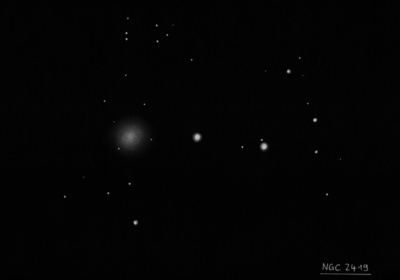
William Herschel discovered NGC 2419 = H I-218 = h457 on 31 Dec 1788 (sweep 901) and wrote "cB, R, vgmbM, about 3' diameter." John Herschel described the globular on 18 Mar 1831(sweep 335) as "not vB; L; pmE in parallel; 2' l and 75" br." This is an interesting observation as the globular is generally described as round. The first time it was logged at Birr Castle on 9 Mar 1850, Lord Rosse remarked "I think clearly resolved, several points, at least 3 seen plainly in edge which I suspect to be filamentous; no nucl., more round than h[erschel] describes it." The 13 Feb 1852 observation even notes "Lord Rosse thought it like a cluster at a great distance."
NGC 2419 was shown to be globular cluster in 1922 on a plate taken at Lowell Observatory. Shapley estimated a distance of 160,000 l.y. (current estimate ~275,000 l.y., nearly twice the distance of the LMC) and along with Sawyer, assigned it concentration class II. He may have been the first to use the nickname "Intergalactic Tramp" in the 1944 paper "Revision of the Distances of 30 high-latitude Globular Clusters."
200/250mm - 8" very faint, small, round, no resolution. Collinear with two mag 8 stars to the west and a mag 9 star in the field W.
400/500mm - 17.5" (3/20/93): fairly faint, round, 2' diameter, gradually brighter core but no well-defined nucleus, mottled appearance although no resolution into stars. Framed by a quadrilateral of four mag 13-14 stars and a few other faint stars. Collinear with mag 7.0 SAO 60232 4' W and mag 7.9 SAO 60229 8' W. The "Intergalactic Tramp" is one of most distant globulars from earth and may be the core of an accreted dwarf galaxy.
Notes by Steve Gottlieb